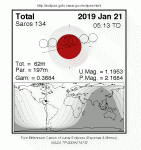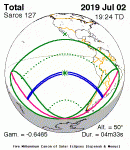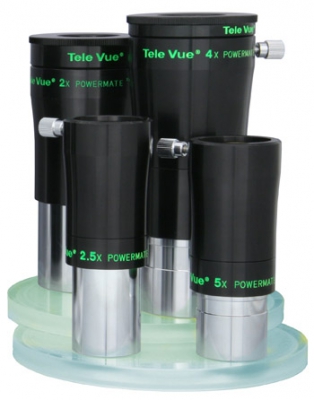2019: Solar and Lunar Phenomena Overview

Mercury Transit
The premier event of 2019 awaits the end of the year when Mercury appears to pass over the face of the sun (as seen from Earth) on November 11th from 12:35 to 18:04 UT. Due to its diminutive size — only 10-arc-seconds in diameter — eclipse glasses over your eyes will not do: you’ll need a properly solar filtered telescope, binocular, or telephoto lens to view it (see Viewing/Imaging Resources at bottom). Don’t miss it as the next transit of Mercury won’t be until 2032.
The transit consists of several phases:
- 1st Contact: At 12:35 UT the Limbs of Mercury and the Sun just touch. The little planet begins its ingress phase over the solar disk for the next 101-seconds.
- 2nd Contact: Mercury’s full disk overlaps the Sun and the ingress phase ends.
- For the next 7½-hours Mercury will pass over the solar disk. Being a time of Solar Minimum, it would be a rare-treat if the planet were to make a pairing with a sunspot. It passes closest to the Sun’s center at 15:19:48 UT.
- 3rd Contact: Mercury’s journey’s end is signaled in the egress phase as it first overlaps the limb of the Sun on the way out.
- 4th Contact: At 18:04 UT, 101-seconds after 3rd Contact, the exiting limb of Mercury just overlaps the limb of the Sun and the transit ends.

Antarctica, Central and Southern America will see all phases. So will eastern North America, the southern tip of Greenland, and the western tip of Africa. The eclipse will be in progress at sunrise for the rest of North America except for a large chunk of Alaska and the extreme northern parts of the Yukon, Northwest Territories, and the arctic regions to the north that will miss it. The transit will still be in progress as the sun sets over the remainder of Africa, all of Europe, the Mideast, and western Russia. Most of Russia, India, and all of China, Japan, and Australia will not see it.
Lunar Eclipses

The first Full Moon of the year (“Wolf Moon”) on January 21st will also be one of the nearest Full Moons of the year (a “supermoon”). For part of the world there will also be a total lunar eclipse — the only one for the year. The Moon will pass through the “umbra” — the deepest part of the Earth’s shadow — and be bathed in the deep-red light refracted through Earth’s atmosphere (as we see at sunset or sunrise). To us, the deep red of sunrise and sunset appear at either horizon. In this phase of the eclipse the Moon will be illuminated by red light skimming the entire circumference of the Earth, as if you are seeing light from sunrise and sunset simultaneously.
Due to the circumstances of this eclipse, the media has dubbed it the “Super Blood Wolf Moon.” The eclipse will be precisely placed for viewing in the Americas. A large part of the rest of the world will see some part of the eclipse with Antarctica, Australia, India, Indonesia, China, Mongolia, central Russia, and Southern Japan missing out.
 |
 |
| Lunar Eclipse maps and data courtesy of Fred Espenak and Jean Meeus, “Five Millennium Catalog of Lunar Eclipses: -1999 to +3000” (NASA/TP-2009-214173). Dark areas see nothing, and shaded areas will see part of the event. See Key to Lunar Eclipse Figures. | |
About six month later, on July 16th, a partial lunar eclipse will be visible in many areas that missed the total event on January 21st. Most of Africa, the Mideast, central Europe, eastern Russia, western India, and Antarctica will see the whole event. North America and the eastern tip of Russia will miss out with the rest of the world seeing a partial event.
Solar Eclipses
By the time you read this the January 6th partial Solar Eclipse will be over. The path of visibility included northeastern China, all of Japan, northeastern Russia, and the Northern Pacific. It was partially visible in Mongolia and Alaska.
The only total solar eclipse this year is on July 2nd and will favor the southern hemisphere. The path of totality spans the south Pacific and crosses over Chile and into Argentina just south of Buenos Aires. The area of partial visibility just skits Antarctica and reaches Central America to the north.
 |
 |
| Solar Eclipse maps and data courtesy of Fred Espenak and Jean Meeus, “Five Millennium Catalog of Solar Eclipses: -1999 to +3000” (NASA/TP-2008-214170). Green lines denote limits of visibility. Key to Solar Eclipse Figures. | |
An “annular” solar eclipse closes out the year on December 26th. For this type of eclipse, the Moon appears smaller than the Sun and never completely blocks it out. At totality, the Sun forms a ring or “annulus” behind the Moon. (This type of eclipse is never safe for naked-eye viewing without eclipse glasses.) The eclipse center line passes through parts of Saudi Arabia, India, Indonesia, and the northern Pacific Ocean. The area of partial visibility includes all of the Middle East, Mongolia, China, India, Japan, and parts of Russia Australia, and the horn of Africa.
Supermoons, Micromoons, & Blue Moons

Three Full Moons this year will happen around the time of “perigee” when the Moon is closest to Earth. These Moons are closer then normal and much brighter than usual. These “Supermoons” will occur on January 21st (also a lunar eclipse), February 19th (largest of the three), and March 21, 2019.
A “Micromoon” happens when the Moon becomes full near the orbital “apogee” — the furthest point from Earth. We’ll have a single micromoon on September 14th this year. See our Night of the Micromoon blog post for more background.
Spring begins on March 10th and the first Full Moon of the season happens a few hours later. This timing allows the spring season to have four Full Moons. One of the definitions of a “blue moon” is the third Full Moon in a season with four Full Moons. This year that will happen on May 18th. The more popular definition of “blue moon” — the second Full Moon in a month — will not see any examples this year.

Viewing/Imaging Resources
To increase the power of your favorite eyepiece, or for serious imaging though your scope, consider our Powermate™ amplifiers (mobile site). They increase the focal length of your scope with reduced aberrations, greater magnification potential, and compact size compared to typical Barlow lenses. Powermate™ T-Ring Adapters fit on the Powermate lens assemblies to allow attachment of your camera’s T-Ring or other T-threaded imaging accessory. See our Powermate Gallery on Flickr for examples.

To share live views of solar, lunar, and planetary event with friends, use our Fonemate™ smartphone adapter (mobile site) on a compatible Tele Vue eyepiece. Click the camera/ video record button on your phone app to save the view! You’ll also need a proper filter if doing solar imaging. See the last column of the Tele Vue Eyepiece Specification chart for compatible eyepieces.





